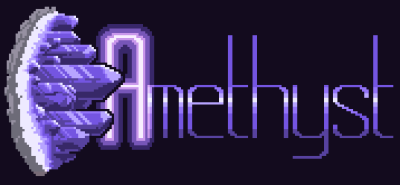amethyst

Amethyst is a small library that enables you to modularize your application by letting you decompose them into Systems, Entities and Attributes in an easy-to-use manner. It is similar to anEntity Component System but it is a bit different in some important aspects.
The core abstraction in Amethyst is the Entity that encapsulates the internal state of our business objects and also their related operations. By using this concept we can maintain the Cohesion) of our business objects while still retaining the flexibility.
So how does this work?, you might ask. Let's take a look at a simple example.
Systems, Entities, Attributes
Let's say that we're creating a game with mythical creatures, and we want to add a goblin to our game.
If we think about how things can behave and change over time we can conclude, that there are essentially two ways:
internal, and external. For example a goblin can decide that it wants to explore a dungeon, or just take a
look around (internal change), or the player can decide to bash the goblin to a pulpy mass with their club
(external change). For this Amethyst has Systems in place:
/**
* A [System] is responsible for updating the internal state of an [Entity].
* The internal state is represented by [Attribute]s.
*/
interface System<C : Context>
There are several types of Systems, and for our discussion here we need to know about Behavior:
/**
* A [Behavior] is a [System] that performs autonomous actions whenever
* [update] is called on them.
*/
interface Behavior<C : Context> : System<C>
that lets our goblin interact with the world and Facet:
/**
* A [Facet] is a [System] that performs actions based on the [Message] they receive.
* Each [Facet] only accepts a single type of [Message] of type [M]. This enforces
* that facets adhere to the *Single Responsibility Principle*.
*/
interface Facet<C : Context, M : Message<C>> : System<C>
that lets whe world interact with our goblin.
There is also
Actorwhich combinesFacetandBehavior. We'll talk about it later.
When changes happen over time to an entity (our goblin in this example) its state might change.
To represent this, Amethyst gives us Attributes:
/**
* An [Attribute] represents metadata about an entity that can change over time.
*/
interface Attribute
An Attribute can be anything that you add to your entity, from health points to stomach contents.
What's important is that Attributes should never have behavior, they are supposed to be dumb data structures.
On the other hand, Systems should never have internal state. These two important rules allow us to compose Systems
and Attributes into Entity objects that are flexible, cohesive and safe to use.
The Entity itself is just a bag of Attributes and Systems:
interface Entity<T : EntityType, C : Context> : AttributeAccessor, FacetAccessor<C>, BehaviorAccessor<C> {
val id: UUID
val type: T
val name: String
val description: String
val attributes: Sequence<Attribute>
val behaviors: Sequence<Behavior<C>>
val facets: Sequence<FacetWithContext<C>>
suspend fun sendMessage(message: Message<C>): Boolean
suspend fun receiveMessage(message: Message<C>): Response
suspend fun update(context: C): Boolean
}
What's interesting here is sendMessage, receiveMessage and update. It is not a coincidence that we have these in
Facet and Behavior! When an Entity receives a Message it will try to apply it to its Facets, and when an Entity
is updated it lets its Behaviors interact with the world. What world means in this context is up to you, that's why
update takes a context object which can be anything. In our case it will contain our World for example.
Don't worry if this seems a bit complex, we'll see soon that the benefits of using such system outweigh the costs.
So how do these entities work together? We have Engine for that which handles them, so we don't have to do it by hand:
interface Engine<T : Context> {
/**
* Adds the given [Entity] to this [Engine].
*/
fun addEntity(entity: Entity<out EntityType, T>)
/**
* Removes the given [Entity] from this [Engine].
*/
fun removeEntity(entity: Entity<out EntityType, T>)
/**
* Updates the [Entity] objects in this [Engine] with the given [context].
*/
fun update(context: T): Job
}
